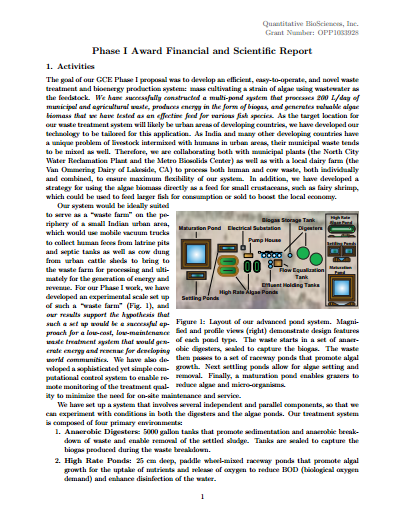Algae for the effective and economical treatment of waste - Various documents on results from research grant
Cookson, N. (2013)

Published in: 2013
Publisher:
Quantitative BioSciences, Inc., San Diego, California, USA
Author:
Cookson, N.
Uploaded by:
SuSanA secretariat
Partner profile:
common upload
4969 Views
27 Downloads
Content - Summary
This library entry contains background documents for a grant that Natalie Cookson is leading and which is funded by the Bill and Melinda Gates Foundation.
Further information and a discussion is available on the SuSanA discussion Forum, see link below.
Short description of the project:
The goal of our project is to develop a full-scale demonstration of a "waste farm," an efficient, easy-to-operate, and novel waste treatment system that will involve mass cultivating algae for the production of bioenergy and a valuable live feed crop for the local community using waste as the feedstock. We are using next-generation biotechnology to characterize and evolve native strains of algae for higher productivity in order to maximize the potential for energy and revenue generation.
Goal(s):
The goal of our project is to develop a full-scale demonstration of a “waste farm,” which could ultimately be set up on the periphery of small urban areas in the developing world. Mobile vacuum trucks will collect human feces from latrine pits and septic tanks as well as cow dung from urban cattle sheds and transport it to the treatment facility for processing and ultimately for the generation of energy and revenue. Our technology will not rely on sewer systems, and it will use a sophisticated computational control system to enable remote monitoring of the treatment quality to minimize the need for on-site maintenance and service. For our Phase I work, we have developed an experimental scale set up of such a waste farm, and we have demonstrated the successful treatment of waste using comprehensive data. In addition, we have shown that the algae grown in our treatment system can be used as an aquatic feed.
Objectives:
Objective 1: Develop a full-scale waste treatment plant. Our focus for Phase II of our project will be on the design, engineering, and testing of a wastewater treatment system that could ultimately be replicated and implemented as waste farms in developing urban areas. We are collaborating with the Van Ommering Dairy in Lakeside, CA, and our process will involve passing a large volume of waste (150,000 liters per day) through a series of biological processes that we will construct on the dairy (Fig. 1, see attached below at the end of the post) to progressively treat waste and convert organic material and nutrients into energy and valuable biomass. The waste will begin in an anaerobic lagoon/digester that will promote sedimentation and anaerobic breakdown of waste. This large lagoon (22 million liters) will be covered to prevent the escape of methane, carbon dioxide, and odors. The waste will next pass to a set of high rate algae ponds (230,000 liters), which will support vigorous algae growth for the uptake of nutrients and enhanced disinfection of the water. Finally, wastewater will be transferred to a fairy shrimp pond (319,000 liters) for algae filtration and to a maturation pond (1.2 million liters) for final treatment that promotes removal of micro-organisms by solar radiation, sedimentation and protozoan grazing. Tilapia will be grown in the maturation pond, feeding on any remaining algae.
Objective 2: Algae identification and evolution. Our innovative approach to enhancing algae-based wastewater treatment will involve the novel application of two avenues of biotechnology (Fig. 2). First, we will use next-generation sequencing to characterize the native algae species that grow in our waste treatment ponds. Initial experiments have revealed hundreds of species of algae and bacteria in our system, and we will use this technology to fully characterize the ecology of the ponds in order to understand how it evolves over time and to determine which species are dominant. We will then use novel microfluidic technology pioneered by our group to rapidly evolve the species of interest for enhanced productivity. Once we have achieved the desired characteristics, we will reintroduce these enhanced native strains back into the pond system, and we will seed the ponds as necessary to maintain the strain of interest in the continuously growing algae culture.
Objective 3: Development of fairy shrimp as a feed. Prominent algae species determined by the sequencing efforts will be cultured in lab and fed to fairy shrimp. Fairy shrimp eggs are capable of drying out, becoming cysts that are capable of withstanding heat, cold, and prolonged desiccation, making them an excellent feed product as they can be shipped dry and then rehydrated into a live feed (Fig. 3). We will experiment with feeding quantities and culture conditions to develop a protocol to optimize the conversion of algae to fairy shrimp biomass. On the farm, we will construct smaller-scale experimental ponds where we can test the viability and proliferation of the fairy shrimp in a competitive outdoor environment and can develop protocols for the collection and desiccation of cysts for sale or use as a live feed for fish.
Start and end date: End date 30 April 2013, final report due 15 June 2013
+++++++++++
Documents available for download below:
1 - Phase I award financial and scienti?c report: Algae for the effective and economical treatment of waste
Bibliographic information
Cookson, N. (2013). Algae for the effective and economical treatment of waste - Various documents on results from research grant. Quantitative BioSciences, Inc., San Diego, California, USA
Filter tags
English Fundamental research and engineering North America















